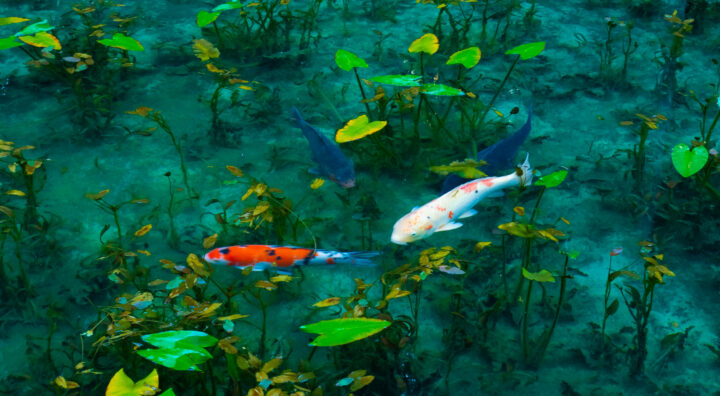
Have you ever found your once vibrant pond turning green before your eyes? Or despaired as your hard work is slowly covered under a layer of algae?
Green water is a murky menace that can turn your tranquil oasis into an eyesore, leaving you wondering what went wrong. Luckily, the solution for tackling green water is as clear as the pond you want. Let’s delve into the world of green water, understand the science of a healthy pond, and explore how pond cleaning products like algae blocks can keep your water crystal clear.
Understanding green water
Green water is a common problem in backyard ponds. It’s caused by an overgrowth of algae, which thrive in pond environments rich in phosphorus and nitrogen, especially when in sunny spots.
However, ‘green water’ is only one type of algae. ‘Algae’ is a diverse group of organisms, and understanding which type you’re dealing with is the first step to choosing the right pond cleaning products.
- Green water is caused by single-celled phytoplankton, which are so small they pass through pond filters. The organisms remain suspended in the water, making your pond appear (you guessed it) green, cloudy, and unpleasant.
- String algae or hair algae grows in long strands, often appearing on rock features before making its way into the pond. Individual strands quickly tangle together, forming a mat over the water’s surface.
Algae are unusual in that they are not technically plants or animals although, like plants, they photosynthesise sunlight into oxygen. After sunset, they ‘respire’ using stored energy, which pumps harmful CO2 into your pond. As well as reducing oxygen levels in the water, algae clogs filters and pumps, leading to a potential pond catastrophe.
Four ways to fight green water and algae
1. Reducing nutrient levels in the water
The nutrients that feed green water come from various sources, including fertilisers, animal waste, excess fish food and decaying plant matter.
Removing excess plant matter, switching to high-quality fish food (for better absorption and less waste), using a pond vacuum to clean up debris, and avoiding using fertilisers near your pond can cut off algae’s supply line. However, this approach is slow and inexact, often leading to an endless cycle of algae blooms and interventions.
2. Adding beneficial bacteria to the water
Algae needs nutrients to grow. Introducing a competitor for those nutrients – in the form of beneficial bacteria – deprives algae of the nutrients it needs.
Beneficial bacteria can gradually reduce green water. However, it’s usually more effective as ongoing preventative maintenance than as a cure for green water.
3. Using an algaecide
Algaecide is the most straightforward way to eliminate algae and prevent new growth in your pond. After dosing your pond with an algaecide like diuron, you should see a clear difference within a week or two.
Algaecides come in several forms, including liquid solutions like Aquapro Algaway and slow-release Aquapro Pond Algae Blocks. Liquid solutions are usually better for ornamental fish ponds, and are best used after physically removing whatever algae you can. Pond algae blocks finish the job, ensuring algae doesn’t bloom again. It’s important to add beneficial bacteria after using an algaecide so that the decaying algae doesn’t trigger the excess nutrient cycle again.
Treatment tip: While algaecides like pond algae blocks are a straightforward way to restore your pond’s brilliance, careful dosing and constant oxygenation are vital for preserving the ongoing health of fish and desirable plants.
4. UV treatment
UV clarifiers, or UV sterilisers, work by exposing water to ultraviolet light, which damages the DNA of algae cells and prevents reproduction.
Over time, the damaged algae cells clump together, and the pond’s filtration system removes them.
UV treatment is effective against a broad spectrum of growth, including green water algae and string algae, providing continuous protection without harming fish or plants. However, UV treatment only controls algae growth. It doesn’t address underlying nutrient sources.
What is the best pond cleaning product?
Maintaining a healthy pond often requires a comprehensive approach combining physical, chemical and environmental measures.
In other words, there is no “best” pond health solution for everyone.
Ponds are complex and wondrous ecosystems. When algae appear, try to think about the interplay of conditions that led to their growth:
- Sunlight
- Nutrient sources and competition
- Water temperature
- Circulation
- pH levels
- Runoff and pollution
- Fish waste
Which method (or methods) you choose depends on the size of your pond, the severity of the algae issue, and the specific conditions of the water.
You can find everything you need to keep your pond pristine and algae-free in our pond care and filtration range. From pond algae blocks to a combination of UV Pressure Filters & Filtration Pumps, Aquapro pond cleaning products help you create a bit of brilliance in your backyard.
